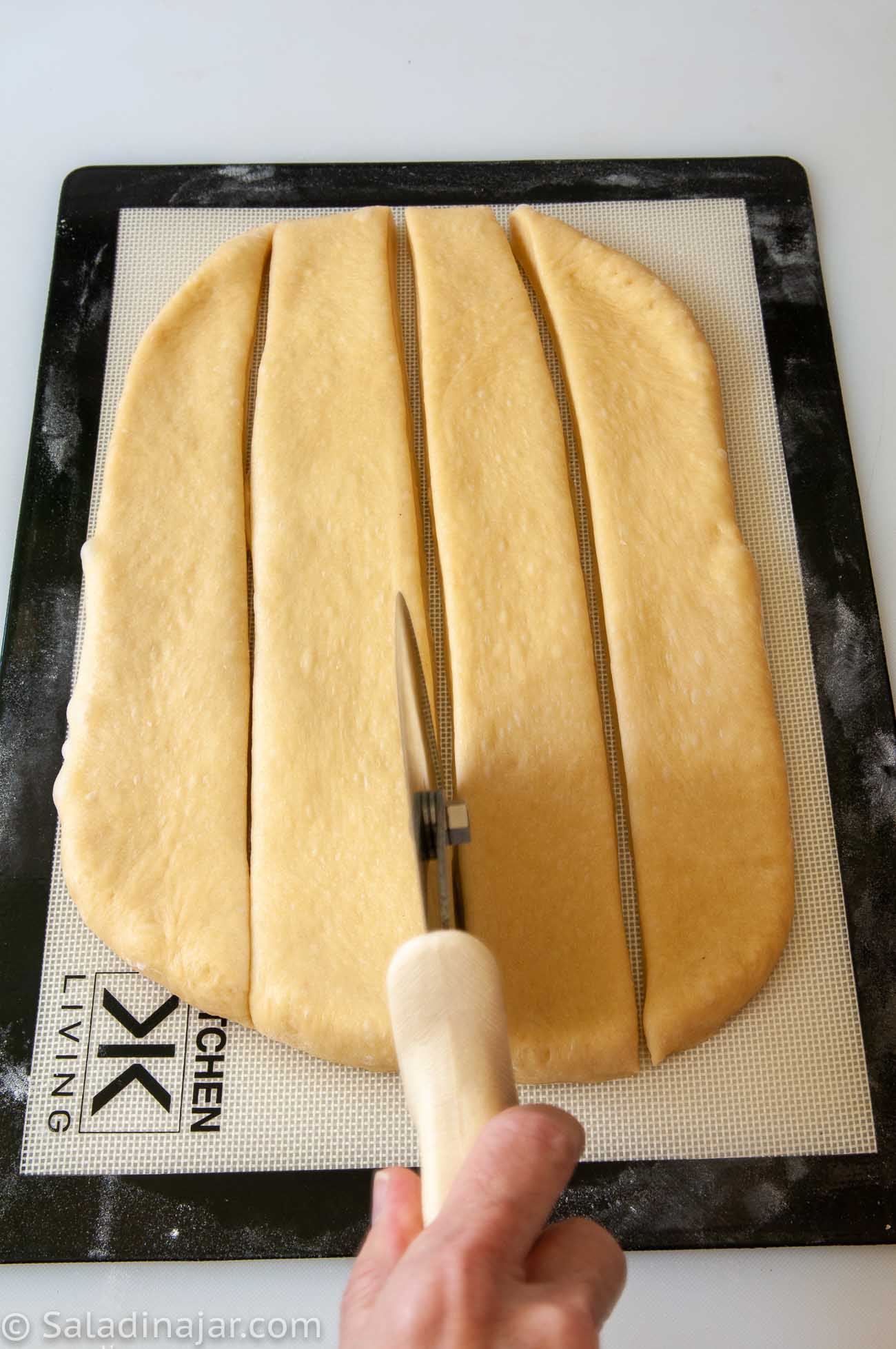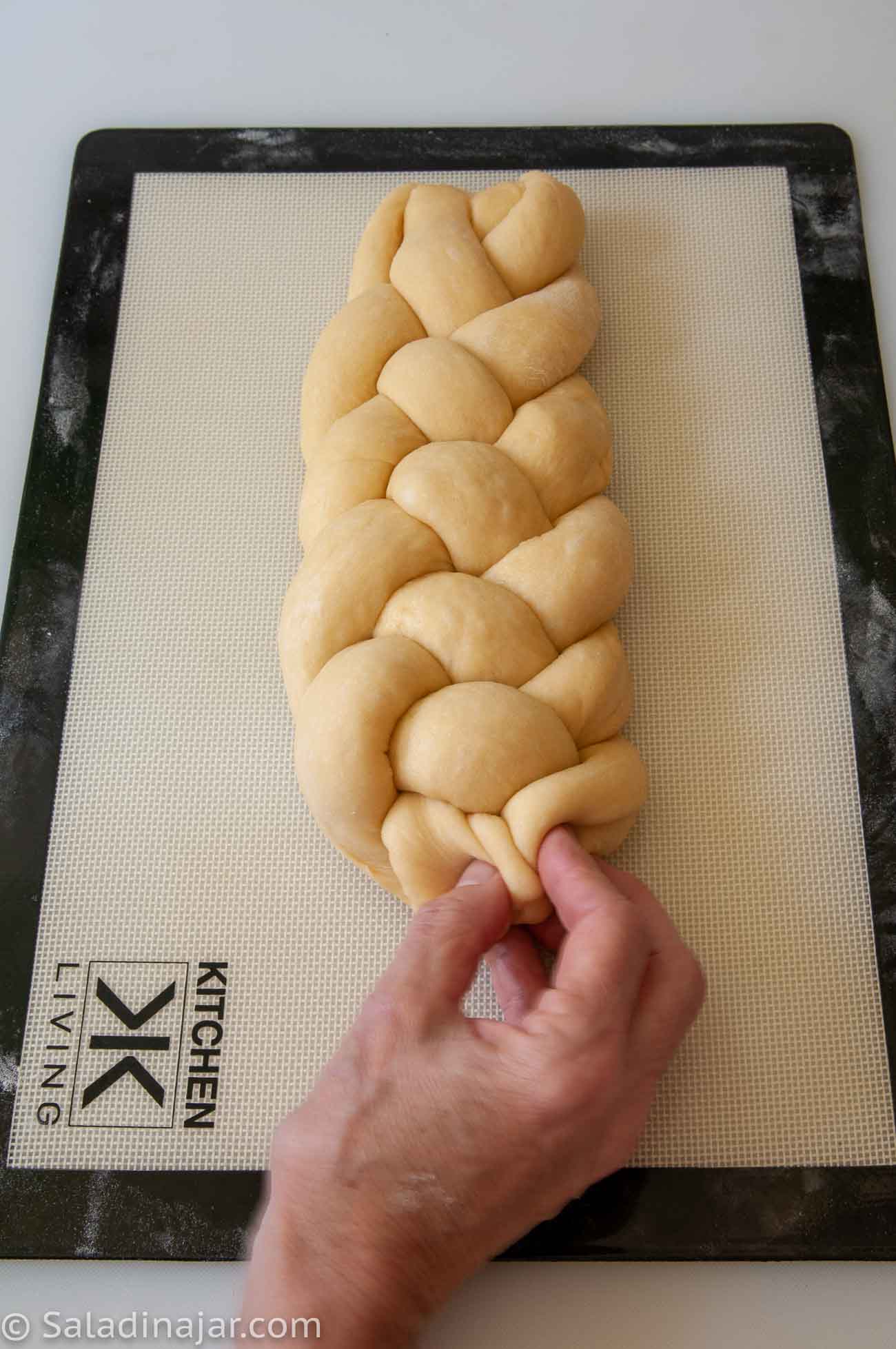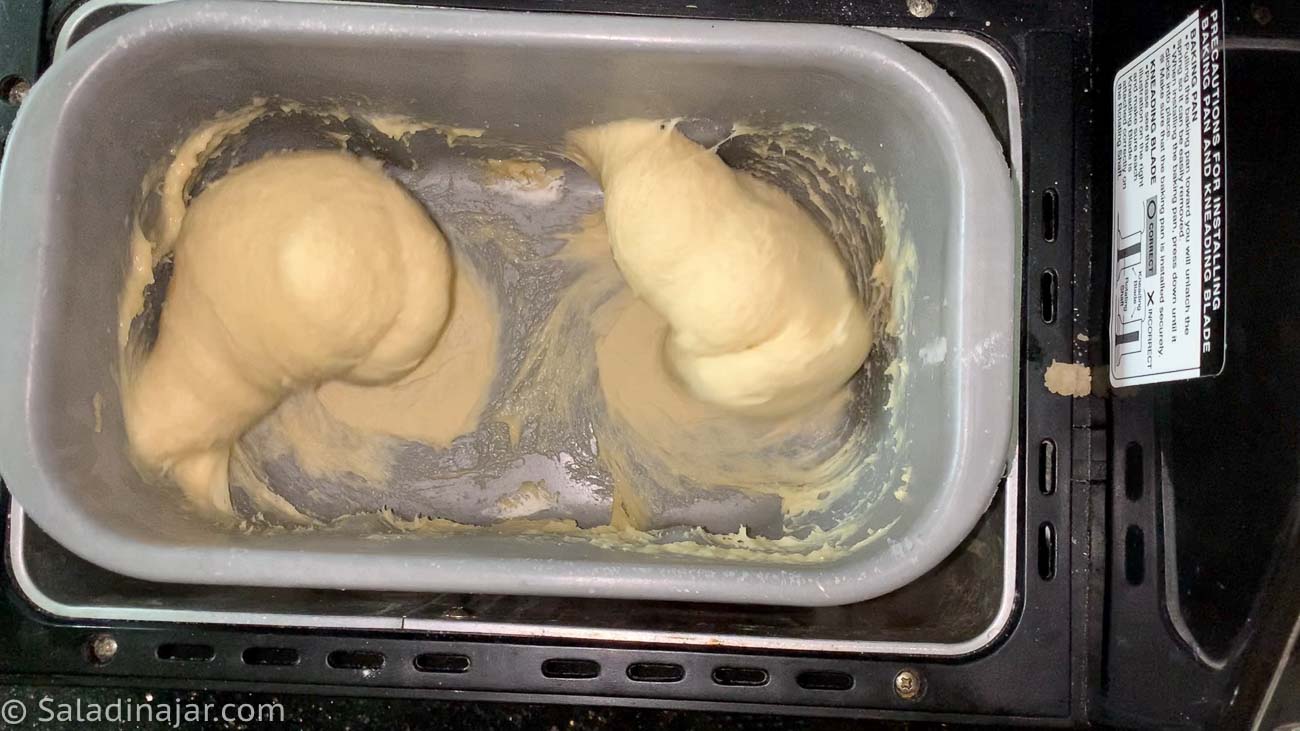A Bread Machine Challah That Makes a Grand Entrance
Sneak Peek: Bread Machine Challah, a traditional Jewish bread, is easy to mix up and knead in a bread machine. This particular version is dairy-free and sweetened with honey. Don’t be surprised by all the reactions you get when you bring this bread to the table.

As an Amazon Associate, I earn from qualifying purchases.
Challah is said to hold rich symbolism regarding the daily manna God provided for the Israelites in the desert for years. I don’t really enjoy eating the same food for three days in a row (unless it’s ice cream), much less for 40 years as the Israelites did. Oh my!
If you don’t have a bread machine, see the directions in the recipe notes for using a large stand mixer or making it by hand.
Have you ever wondered about the correct pronunciation of the name of this bread?
You don’t pronounce the “ch” like you would say church. The way I understand it, the first sound should be more of a guttural “h.” You can listen to the correct (supposedly) pronunciation online.
Happy Bakers Speak Up
“I was amazed first of all at how easy it was, and then at how good it looked and tasted. The first one I made came out perfectly and tasted amazing. I’ve since made more and added sesame and poppy seeds which were also great.” —KAREN
Recipe Inspiration
This bread is quite special because it’s full of eggs – it uses three! I also made a small change by using honey instead of sugar. This makes the bread not too sweet and helps it stay really soft and moist.
Let’s talk about the simple ingredients you’ll need.
Ingredients and Substitutions

- WATER: I keep a gallon of spring water in the house for bread-making. Chlorine and yeast aren’t best friends. If you don’t have any spring water on hand, tap water will work. That’s what I used for years.
- EGGS: Use large-size eggs. If you use extra-large eggs, cut back on the liquid. If you use medium eggs, increase the liquid slightly.
- HONEY: Substitute sugar for honey if that’s what you have. My original recipe called for 1/4 cup of sugar. I recently changed it, and I love how the honey makes this bread moister and not quite so sweet.
- SALT: Use table salt or sea salt. If you prefer Kosher salt, add 1/4 teaspoon.
- BREAD FLOUR: In the past, I used all-purpose unbleached flour in this recipe. It turned out fine, but I like bread flour’s texture and rise better.
If possible, weigh your flour. At the very least, don’t scoop the flour with your measuring cup. You’ll most likely end up adding too much. - YEAST: Instant or bread-machine yeast (same thing) is a fast-acting yeast. It will hit the floor running.
You could substitute active dry yeast. It’s no longer necessary to dissolve it and wait, but you can if you want to. - VEGETABLE OIL: My favorite vegetable oil for this bread is avocado, but corn or canola oil is also good.
You may notice the instructions tell you to add the oil a minute or so after starting your machine. I find this works better and makes a nicer texture. If you forget and add all the ingredients at once, like normal, don’t fret. It will be fine. Proceed as usual.
Whether you make a 3-braid loaf or a 4-braid loaf is your choice. Either way, don’t get in a dither about the braid. You can always press the dough together, knead until smooth, and try again.

How To Make a 3-Strand Braid with Bread Dough

How To Shape a 4-Braid Challah










If you find this hard to follow, I made a video for you. If you’re still confused, search YouTube for a video that speaks to you. There are several ways to accomplish this task, but this method worked for me.
How To Assemble a Challah Recipe with a Bread Machine












FAQ About Bread-Maker Challah
Challah is a parve loaf traditionally made without any dairy products. Use oil instead of butter. Both egg bread and Challah have lots of eggs.
Brioche is similar in its soft, sweet, and fine texture, but it has LOTS of butter.
Yes. Use a stand mixer or mix and knead the dough by hand. (See the recipe notes for details.)
The advantage of a bread machine is that it automatically mixes and kneads the dough for the perfect amount of time. No more worries about under or over-kneading.
Yes. Make two ropes and twist them. Or form the bread into a ball or oblong. You could even fill a loaf pan and make a Challah loaf. It won’t be traditional, but the flavor and texture should still be fabulous.
Avoid this, as the flavor will be overly yeasty, and the texture will not be light and fluffy.
You could try re-kneading the bread for a minute, roll it out, and re-braid it. Let it rise again (watch it closely) and bake. No guarantees, but it’s worth a try.
Don’t leave off the egg wash. It’s important to produce the gorgeous glaze characteristic of Challah.
The most reliable method is to use a quick-read thermometer. It should read 200˚- 205˚F when carefully poked into the middle of the bread.
Experienced breadmakers can tell by the hollow sound heard when tapping the bottom of the loaf. (I’ve been making bread for over 40 years, and I still prefer to use a thermometer. It’s fail-proof.)
If you notice it’s getting too brown, lay a sheet of foil over the top. Next time, try moving the baking rack slightly lower in the oven.
Wait at least one hour while Challah cools on a rack before slicing. If you can’t resist, slice off only the smallest piece from one end (when nobody is watching–you don’t want to start a stampede).
When you slice it, use a serrated knife that doesn’t rip the bread.
Challah tends to stale quickly because it contains a lot of honey and fat, although the eggs help keep it fresh. What you don’t eat after the first couple of days will make good French toast, bread pudding, or a breakfast casserole on succeeding days.
Yes. Be sure to double-wrap the baked bread. Use plastic wrap, then place it in a plastic bag or wrap it securely with foil. Keeps for about a month.
Yes. Make the dough in your bread machine. Remove it at the end of the DOUGH cycle and shape it. Cover and refrigerate immediately.
Remove the shaped dough a couple of hours before you want to bake it, and let it come to room temperature. When the dough is puffy, bake it in a preheated oven.
This happens more often with the three-strand braid. If it bothers you, make the four-strand brand. Compare the pictures above.
Parting thoughts: I love to braid bread. After a little practice, it’s pretty easy, and it makes a grand entrance. If you feel the same way, check out the recipe for this Cardamom Bread and my Banana Whole-Wheat Bread Machine Bread.
Recipe Help at Your Fingertips: For questions or suggestions, email Paula at saladinajar.com. If you need help, I’m happy to troubleshoot via email (faster than leaving a comment). Attach pictures and as many details as possible for the best advice.

Bread-Machine Challah Recipe (Dairy-Free)
Rate this recipe
(5 stars if you loved it)
Video
Ingredients
Dough
- ¼ cup + 2 tablespoons (75 g) water
- 3 large (150 g) eggs
- 2½ tablespoons (52 g) honey
- 1¼ teaspoon table salt
- ¼ cup (50 g) vegetable oil
- 3 cups (360 g) bread flour
- 2 teaspoons bread-machine or instant yeast
Egg Wash Glaze
- 1 (18 g) egg yolk
- 1 tablespoon water
- pinch table salt
Instructions
Mixing the dough:
- Add ¼ cup + 2 tablespoons (75 g) water to the bread machine.
- Add remaining ingredients: 3 large (150 g) eggs, 2½ tablespoons (52 g) honey, 1¼ teaspoon table salt, ¼ cup (50 g) vegetable oil, 3 cups (360 g) bread flour, 2 teaspoons bread-machine or instant yeast in the order given using the lesser amount of flour.
- Select the DOUGH cycle and start.
- Check dough after it has been mixing for about 12-15 minutes. The dough should stick to the side and pull away cleanly. If dough is too sticky, add more flour 1 tablespoon at a time. (I usually end up adding 1 tablespoon of flour to this dough.) If too dry, add 1 tablespoon of water at a time. See this post about the most important thing you should do when using a bread machine.
- At the end of the DOUGH cycle or whenever dough has risen to double its original size (open the lid and check), remove dough to a floured surface.
Shaping the dough:
- Roll into a rectangle 9 x 14 inches. Cut into three or four strips. Use fingers to pinch long sides of each strip so you now have 3 or 4 cylinder-shaped pieces of dough. (See picture above.)
- Loosely braid strips, tucking the strips on each end under the braid to make a neat loaf. Place onto a heavy cookie sheet covered with parchment paper or a silicone mat. You could also spray your cookie sheet with aerosol oil/flour like Baker’s Joy.
- Cover formed Challah with a tea towel and allow to rise until almost doubled. Preheat oven to 350˚F (180˚C) for about 20 minutes before the bread is ready to bake.
- Brush the entire loaf with egg wash (see below) and place your oven rack in the lower middle of your oven. Bake in the oven for 30 minutes or until the interior temperature reaches 190˚F (88˚C). Cover after 10-15 minutes, if necessary, to prevent the loaf from over-browning.
- Move loaf from cookie sheet to rack and allow to cool for 1 hour before slicing.
Egg wash:
- With a whisk or fork, combine 1 (18 g) egg yolk, 1 tablespoon water, and a pinch table salt in a small bowl.
Notes
Alternate Mixing Instructions:
Directions for making bread with a stand mixer or by hand:
- To make this recipe in a heavy-duty stand mixer, add ingredients to the bowl in the same order. Turn on low to mix until all ingredients are moistened. Using a dough hook, turn speed to 2 or 3 and continue beating/kneading until dough becomes smooth and elastic (about 5-10 minutes). Cover and allow to rise in a warm place. Deflate dough gently and shape as indicated in the recipe.
- If making by hand, combine all ingredients into a shaggy ball in a large bowl. Turn dough out onto a floured surface and knead with your hands until dough becomes smooth and elastic, a process that will likely take 10-20 minutes depending on your experience. Place the dough ball into a greased bowl. Cover and allow to rise until double. Deflate dough gently and shape as indicated in the recipe.
- Please note: You can substitute active dry yeast for instant or bread machine yeast. Add 1/4 teaspoon extra yeast when using the active dry yeast. According to King Arthur Flour, there is no longer any need to dissolve it. Be aware that it may be a little slower acting than instant yeast, but it’ll get there. https://www.kingarthurbaking.com/blog/2015/09/25/active-dry-yeast
Equipment
Nutrition
All images and text ©️ Paula Rhodes for Salad in a Jar.com
I modified this Challah recipe from the book More Bread Machine Magic (paid link) by Linda Rehberg and Lois Conway.





Paula Rhodes, owner
As a retired home economist, I created Saladinajar.com to share my belief that you don’t have to be a chef to find joy in creating homemade food worth sharing. Bread machines (used in an unconventional way), homemade yogurt, and quick microwave recipes are my specialty.